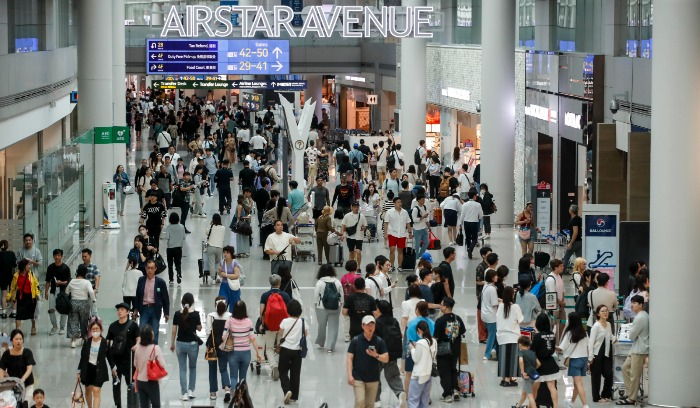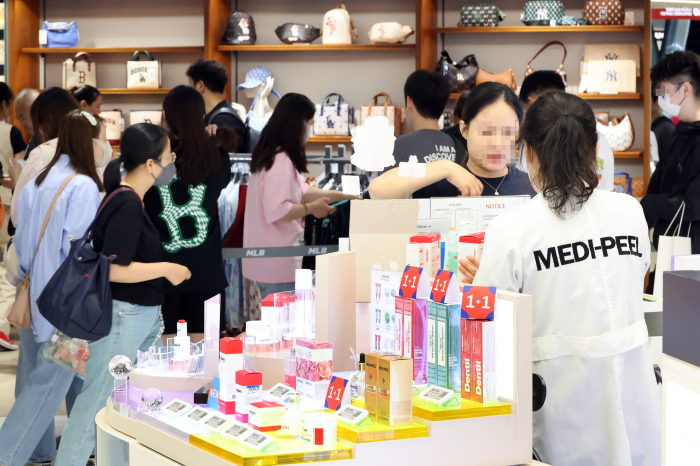Retail
Korea’s duty-free sales skid despite China border reopening
Duty-free shops are turning to Southeast Asian visitors, while prioritizing profits over sales growth
By Aug 02, 2023 (Gmt+09:00)
2
Min read
Most Read
LG Chem to sell water filter business to Glenwood PE for $692 million


KT&G eyes overseas M&A after rejecting activist fund's offer


Kyobo Life poised to buy Japan’s SBI Group-owned savings bank


StockX in merger talks with Naver’s online reseller Kream


Meritz backs half of ex-manager’s $210 mn hedge fund



South Korea’s duty-free shops suffered a sharp decline in sales in June, when the number of Chinese visitors jumped more than three times that of February, just before China reopened its borders.
Despite the rebound in the number of Chinese visitors, there are few signs of their sales picking up this year, industry observers say. China has excluded South Korea from overseas destinations for group tours amid diplomatic tensions between the two countries.
According to the Korea Tourism Organization, a total of 168,000 Chinese traveled to South Korea in June, compared to 46,000 in February of this year.
However, duty-free shops in the country saw their sales contracting by 8.9% to 854.3 billion won ($660 million) in June, versus the previous month’s 938.1 billion won, according to the Korean Duty-Free Shop Association. Year on year, June revenue decreased by 35.8%.
According to the South Korean Embassy in China on Tuesday, the number of visas it issued to Chinese nationals recovered to pre-pandemic levels in June.
The same month, it issued a total of 114,109 visas to Chinese travelers to South Korea, above the 112,170 of June 2019. China came second in terms of the number of visitors to South Korea last June, after Japan.

This time around, the vast majority of Chinese visitors are individual travelers, who tend to travel on a budget, because of China’s ban on group tours to South Korea.
Chinese visitors in group tours used to snap up a bundle of duty-free cosmetics and bags to resell them to Chinese locals for a profit.
“Individual Chinese travelers spend one-third that of group tourists,” said a duty-free shop employee in Seoul.
“They’re more interested in going to restaurants, cafes and tourist attractions than shopping.”
Chinese young consumers’ patriotic spending, or preferring local brands over foreign products, was also attributable to the drop in Chinese travelers’ spending in Korea.
According to China’s customs office, China’s imports of South Korean cosmetics dwindled for a fourth straight month in July of this year.

To fill the vacancy left by Chinese travelers, duty-free shops are turning to Southeast Asian visitors.
The number of foreign visitors from Vietnam, Thailand and Taiwan jumped 3.5-fold in the first quarter of this year, compared to the same month of 2022.
Three major duty-free shop operators -- Lotte, Shilla and Shinsegae -- prepared product leaflets in the languages of Vietnam, Thai and other Southeast Asian countries. They set up reception desks to serve visitors from these countries.
Additonally, they have put their priority on lifting profits rather than boosting sales volume.
They are also negotiating with travel agencies and tour guides to cut the fees they pay in return for bringing Chinese group tourists to their stores.
Industry observers said Shilla Duty Free Shop’s second-quarter results seemed to reflect such efforts.
Its operating profit nearly tripled to 43.2 billion won, versus the previous year’s 14.8 billion won. Its sales contracted 30% to 708.1 billion won on-year.
Write to Mi-Kyoung Lee at capital@hankyung.com
Yeonhee Kim edited this article.
More to Read
-

-
 Travel & LeisureJapan sends most tourists to S.Korea in May: tourism body
Travel & LeisureJapan sends most tourists to S.Korea in May: tourism bodyJun 29, 2023 (Gmt+09:00)
1 Min read -

-

-
 Travel & LeisureChinese buy cosmetics, Japanese pick groceries in Korea: Survey
Travel & LeisureChinese buy cosmetics, Japanese pick groceries in Korea: SurveyApr 26, 2023 (Gmt+09:00)
2 Min read -
 Travel & LeisureSeoul reclaims spot as Japanese tourists' top destination after 11 yrs: HIS
Travel & LeisureSeoul reclaims spot as Japanese tourists' top destination after 11 yrs: HISNov 28, 2022 (Gmt+09:00)
1 Min read -
 RetailJeju as Korea's new shopping mecca: Shinsegae's task ahead
RetailJeju as Korea's new shopping mecca: Shinsegae's task aheadNov 04, 2021 (Gmt+09:00)
2 Min read
Comment 0
LOG IN


